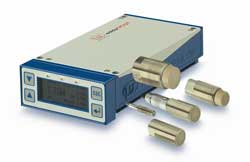
Posted to News on 27th Jan 2008, 22:13
Eddy current sensors monitor pump performance
Non-contact eddy current displacement sensors from Micro-Epsilon are being used on test rigs to help evaluate the leakage and pressure distribution for axial piston pumps.

The School of Engineering at Cardiff University is carrying out research to help evaluate the leakage and pressure distribution for axial piston pumps and to analyse the dynamic behaviour of the barrel. The research is also concerned with the force and torque between the barrel and the port plate of an axial piston pump. This could enable pump manufacturers to develop axial piston pumps with improved port geometry, therefore reducing overall noise and vibration levels.
Three separate eddyNCDT (U05) sensors from Micro-Epsilon are being used on the test rig to measure the dynamic displacement of the barrel as it rotates at around 1440rpm.
John Watton, head of the research project at Cardiff School of Engineering, comments: "A detailed set of new equations has been developed to take into account important parameters such as tilt, clearance, rotational speed and timing groove. Of particular novelty is the prediction of a double peak in each torque fluctuation resulting from the more precise modelling of the port plate-timing groove pressure distribution characteristics during motion. A comparison between the temporal torque fluctuation pattern and other work shows a good qualitative agreement. Experimental and analytical results for the current study demonstrate that barrel dynamics do contain a component primarily directed by the torque dynamics."
Sensor set-up
The three eddyNCDT U05 sensors, which have dimensions of 2mm diameter by 4mm in length (with a 0.5mm diameter sensor cable) are positioned on a 50mm radius around the port plate on the test rig, measuring to an accuracy of 0.1um. Displacement measurements around the barrel need to be taken so that the central displacement can be set. According to Watton, the test rig required very accurate displacement sensors that could measure down to a tenth of a micron: "Each sensor calibration showed excellent linearity and produced calibration factors of 47.75um/volt. The barrel dynamic displacement was measured at 180bar and the results showed at least two waves superimposed, the main wave having a frequency of around 24Hz, which was the pump rotational frequency, and the frequency of the second wave being nine times that of the pump frequency."
The barrel dynamics were first evaluated by considering the torques generated by the fluid pressure between the barrel and the port plate, which required a complex solution of Reynolds equation of lubrication. Once the torques acting over the barrel swash plate system are known, the theoretical barrel dynamic motion can be calculated. Watton adds: "Filtering of the higher-frequency effects, typically 1kHz, showed a promising comparison between theory and measurement."
These research results, and other results on slipper leakage using the same sensors for slipper position, have been discussed with overseas pump manufacturers, who, Watton says, "were more than a little interested in the findings." The barrel motion dynamic results have recently been published in the ASME Journal of Dynamic Systems, Measurement & Control, Jan 2008, Vol 130.
Eddy current displacement measurements
Micro-Epsilon's range of eddy current displacement sensors measure distance, displacement or the position of any electrically-conductive target. The principle enables non-contact and wear-free measurements to be made. The measurement objects can have either ferromagnetic or non-ferromagnetic properties and, because of its immunity to oil, dirt, dust, moisture and interference fields, the eddy current principle is highly suitable for applications in harsh industrial environments. Micro-Epsilon's claims that its eddy current sensors are the only ones on the market today with field calibration capability and active temperature compensation, which ensures a stable signal to be output.
Aside from the standard eddyNCDT range of sensors, miniature sensors are also available that achieve high-precision measurement results with extremely small dimensions. Pressure-resistant versions, screened housings, ceramic types and other special features characterise these sensors. The miniature sensors are used in high-pressure applications, for example, in internal combustion engines. The sensors can be used from -50 up to 235degC. The wide temperature range and insensitivity to dirt or dust offers the potential for a huge range of applications in industrial environments. Whereas currently available eddy current sensors typically exhibit extreme drift with variations in the ambient temperature, active temperature compensation with the eddyNCDT sensors ensures excellent signal stability.
No. 1 Shorelines Building
Shore Road
CH41 1AU
UNITED KINGDOM
+44 (0)151 355 6070






























